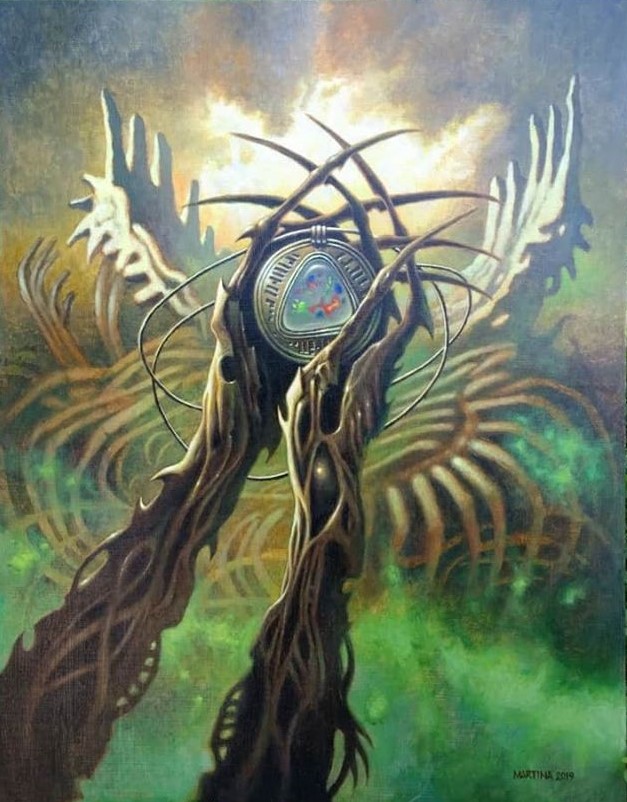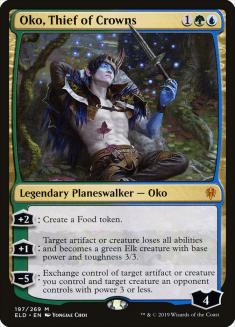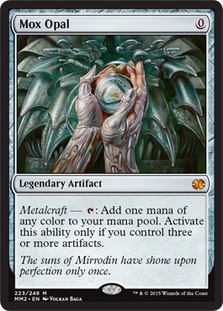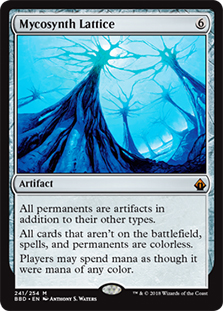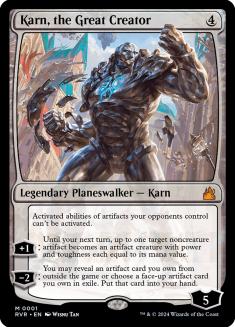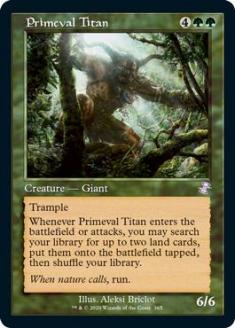Welcome to another edition of Fact or Fiction! Today Ari Lax, Shaheen Soorani, and Sam Black are here to give their takes on five statements on the January 3rd Banned & Restricted Announcement. Don’t forget to vote for the winner at the end!
1. Banning Oko, Thief of Crowns in Modern was a good decision.
Ari Lax: Fact. It is now 2020 and I’m done talking about this card. I’m unsure any single card has ever been more damaging to Magic for so many reasons and would prefer it just full-on got unprinted so we never had to discuss it again.
Shaheen Soorani: Fact. This should have occurred in the last cycle of bannings. Calling Oko a mistake is the understatement of the century. Invalidating archetypes, deck homogenization, negative viewership, and boring gameplay are just some of the negatives this planeswalker has brought in all formats that it was a part of.
There is some truth to the argument that Oko created skill-intensive matches in Modern. This piece is evident, as we have seen some of the best players consistently finish highly wielding the best planeswalker of all time. For the few competitive players that loved having it in the format, the rest of the world is better off with it being gone. Magic Twitter is not the best pulse check on the health of a format and I am guilty of regularly zeroing in on only the competitive metric for bannings. Modern is arguably the most popular format in the game and this move was required to keep it that way.
Sam Black: Fact. Are we really going to pretend this was a question?
2. Banning Mox Opal in Modern was a good decision.
Ari Lax: Fact, but the truth hurts. Mox Opal is not a fair Magic card. How it survived almost a decade of Modern legality is beyond me.
But those eight years gave the card a lot of interesting history. Affinity was the only good deck that was still legal and good from Modern’s inception at Pro Tour Philadelphia through the present era. This is like sharks going extinct.
And unlike Faithless Looting, I’m unsure Mox Opal was always the root cause of the issues it was involved with. Affinity and Hardened Scales were fair, the Prison decks beatable exploits. Some broken mana engine was what caused the bans, and how much should you be pushing zero- or one- mana artifacts anyway? Graveyard stuff is interesting in Standard until it hits Faithless Looting-powered enablers and Prized Amalgams should keep seeing print in careful quantities, but does Mox Opal get that much better without future Arcum’s Astrolabe-level mistakes?
I can’t say it was wrong to ban Mox Opal, but it feels sad and not relieving to see it go.
Shaheen Soorani: Fact. This one hurts. Mox Opal had to go eventually, and I was surprised to hear it exited with Oko today. The reason why it hurts is purely a financial reason, as many players invested hundreds of dollars into the most powerful accelerant that the format has to offer. Mox Opal has always been the problem and many artifacts paid the ultimate price for its sins.
The format is now down to Simian Spirit Guide for fast, free mana and that is just fine. If you want to combo people or play a bunch of spells with limited mana, you’ll have to work a little harder for it moving forward. Urza, Lord High Artificer wasn’t happy with the news that the best zero-cost artifact in its arsenal bit the dust, but there will still be openings for the blue legendary creature to get some play in Modern. Other artifact-based decks will all drop significantly in power level; however, this opens the door for R&D to take a few more risks in that department. I look forward to seeing the new iterations of artifact-based decks, as well as seeing more sweet cards printed in the archetype without having the ban fear looming.
Sam Black: Fact. This was one of many possible good decisions, and I think it was likely the best. The goal of the alternatives, like banning Mishra’s Bauble or Arcum’s Astrolabe, would be to “soft ban” Mox Opal, but it wouldn’t have worked. With Oko and Lattice banned, if Astrolabe had taken the fall I’d probably just switch to playing Lantern as the best remaining Opal deck, and no one wants that.
Mox Opal has been the most powerful card in Modern for a very long time. This is a world where people sometimes talk about banning Simian Spirit Guide and where Chome Mox has always been banned. The format is large enough that there was no appreciable cost to putting Mox Opal in your deck, and while a lot of players failed to do this, that doesn’t change the fact that they were making a mistake.
There were short-term Band-Aids available if they determined that Mox Opal was “too big to fail” due to the secondary market value of the card, but for the long-term health of the format, this was a fantastic decision.
3. Banning Mycosynth Lattice in Modern was a good decision.
Ari Lax: Fiction. I’ve said this for a while, but the War of the Spark planeswalkers were great for Modern. They made having creatures in your linear deck relevant, making games more interactive. Mono-Green Tron being supplanted by Eldrazi Tron because you need to block things attacking your Karn-Lattice lock makes the format healthier.
Karn-Lattice was also a ten-mana clean kill combo. Splitting that cost exposes your planeswalker to answers. It isn’t fundamentally worse to play against than Scapeshift or Living End or whatever, and committing to making that much mana is a big deal. Karn has your entire sideboard as a deckbuilding cost, which is huge.
This is the equivalent of banning Valakut, the Molten Pinnacle. If this lock was overpowered, the fault lies with Once Upon a Time, Urza’s Tower, or the London mulligan.
Shaheen Soorani: Fiction. Oh, give me a break. I hate Tron as much as the next person, but there are far worse gameplay patterns in Modern than this ten-mana combination. Mycosynth Lattice requires a clean battlefield to protect Karn and that is not a small task. It will be even more difficult now that Mox Opal is banned, due to players being disincentivized to play artifact-based decks.
Karn was a solid card on its own, especially with the metagame revolving around Urza. The hate it provided on its own boosted the power level, but it was still weak with all things considered. This ban perplexes me and my best guess, outside of the explanation provided, was how unfun the resolved combo was for the opponent. With Blood Moon and Ensnaring Bridge around still, I’m not sure if that reasoning passes the smell test of gameplay enjoyment.
Sam Black: Fact. I didn’t expect this to happen, but their prediction that Tron-based decks would be too good after the other bans is very reasonable, and the ubiquity of the Karn one-card combo likely would have gotten really tedious.
I never would have thought to ask for it at this juncture without it having had a chance to grow into more of a menace, but it fits with other secondary bans they’ve made in anticipation of where the format would go in the past, and I think this is an example where it was really on point.
Mono-Green Devotion, which took second place at SCG Knoxville, is a great example of how it gives decks that otherwise might be pretty narrow an low cost way to threaten on an entirely different axis. With Oko banned, we likely would have seen a similar format with Karn, where every deck that can make extra mana (Tron, Green Devotion, Primeval Titan, and even midrange decks with mana creatures) all play Karn, which sounds miserable.
4. With Mycosynth Lattice banned, Karn, the Great Creator has effectively been banned from Modern.
Ari Lax: Fiction. Karn is now massively worse, but it is still every hate card in a clean package. It is Ensnaring Bridge, Trinisphere, Grafdigger’s Cage, Witchbane Orb, and one-sided Stony Silence.
With a Mox Opal ban, using Whir of Invention as your Prison tutor effect is really difficult. I wouldn’t be shocked to see hybrid Tron-Prison shells popping up that still utilize Karn. The card won’t be as ubiquitous a win condition, but it still has a place in the Modern format.
Shaheen Soorani: Fact. Karn was already on the decline, but would have bounced back with just an Oko ban. It fits smoothly into Tron decks and has also seen play in other big mana decks as a reasonable finisher and toolbox. With the banning of Mycosynth Lattice, the win condition piece is lost, and the combo is officially dead in Modern.
There is a small possibility that artifacts bounce back from some new cards in the future, but it would take a lot to get this planeswalker back up and running. The toolbox feature is still there, providing answers to most of the decks out there, but that is simply not enough to make it viable. In a format where Jace, the Mind Sculptor sees limited play, providing an Ensnaring Bridge on Turn 5 is not a powerful enough sequence for the format.
Sam Black: Fact. With Mox Opal banned as well, the static on Karn also doesn’t do much, and while the toolbox is nice, there are just better four-mana planeswalkers. There’s really nothing to see here.
5. Primeval Titan is now the most powerful card in Modern.
Ari Lax: Fiction. Primeval Titan is fundamentally a capped strategy. You are either a Turn 4 to Turn 5 kill with some interaction, or a Turn 3 to Turn 4 resilient combo deck that can’t interact and isn’t a clean kill. You have issues with Blood Moon, a broadly applicable hate card. You don’t even always beat Tron decks.
Primeval Titan isn’t even the best card in the Primeval Titan decks. And sorry, Zach Allen, it isn’t Summoner’s Pact either. The best card in these decks and the best card in Modern is Once Upon a Time. Mox Opal, Faithless Looting, and Ancient Stirrings were once the power trio of Modern, and Once Upon a Time kicked Ancient Stirrings off that perch while the other two cards got banned.
There were eight copies of Once Upon a Time in the finals of SCG Knoxville. Neither deck played Primeval Titan or Urza’s Tower. Neither deck was Infect. There are numerous overpowered decks just pushed to absurd levels via a free cantrip.
If I were betting on the next Modern ban, Once Upon the Time would be it.
Shaheen Soorani: Fact. Primeval Titan’s number one enemy was removed from the format, making it the most powerful card in Modern. Big mana has always been an issue in the format, producing an outrageous amount of resources much earlier in the game than any other deck. I do not think Scapeshift decks are the danger here, as Amulet Titan does the same thing, but much more efficiently.
In a just world, Field of the Dead wouldn’t exist to make Amulet Titan the best deck by leaps and bounds. Control had a favorable matchup against all Primeval Titan decks for a nice stretch, but the inevitability that Field of the Dead provides, when each Primeval Titan was dealt with, is overpowered. I don’t think they will have to ban Primeval Titan; however, I am confident that they will have to take a piece out of these decks to provide a good matchup to one of the archetypes. Field of the Dead is another mistake in printing that has been removed from Pioneer and Standard, so I think that will be the next hit Modern will take on a future Monday. Until then, I hope I have quick deaths on Turn 3, instead of the demoralizing defeat to Zombies when the disruption “worked.”
Sam Black: Fiction. Whoa. I needed to take a moment to process this one, since I hadn’t thought about the vacuum left by Mox Opal and Oko. Primeval Titan is up there, but it doesn’t take the top slot.
The new most powerful card in Modern is Once Upon a Time, and I actually don’t think there’s another card that meaningfully competes for the title.
Primeval Titan will certainly be a pillar of the format, but Once Upon a Time is about to become the most-played card, and likely the next banned, as it facilitates Tron, Primeval Titan, Devoted Druid, Green Devotion, Heliod Combo, Yawgmoth, and almost every other playable non-blue deck.

